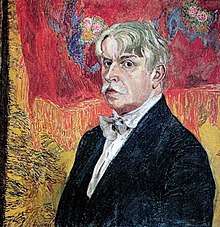Aleksandr Golovin (artist)
| Aleksandr Golovin | |
|---|---|
 Self portrait, 1919 | |
| Born |
March 1, 1863 Moscow, Russia |
| Died |
April 17, 1930 (aged 67) Detskoye Selo, USSR |
| Nationality | Russian |
| Known for | Painting • stage design |
Aleksandr Yakovlevich Golovin (Russian: Алекса́ндр Я́ковлевич Голови́н, Russian pronunciation: [ɐlʲɪˈksandr ɡəlɐˈvʲin]; March 1 [O.S. February 17] 1863 – April 17, 1930) was a Russian artist and stage designer. He designed productions for Sergei Diaghilev, Constantin Stanislavski, and Vsevolod Meyerhold.
Born at Moscow, Golovin initially studied architecture, later switching to painting. He also attended the Académie Colarossi. Due to financial difficulties, upon graduation he worked as an interior painter and decorator. He also tried his hand at various artistic fields such as furniture design. In 1900 he took part in designing the Russian Empire pavilion at the Paris World's Fair together with his friend K.A. Korovin. He studied at the Académie Vitti in Paris.[1] In 1901 he moved to the Saint Petersburg region from Moscow. It was here that he came into his own as a stage designer, combining symbolism and modernism on operatic and dramatic productions for Diaghilev, Meyerhold and others. After the Revolution of 1917, Golovin found work in theatre less and less often, and so delved into painting and graphic illustration.
Golovin provided the set design for the 1910 original production of Stravinsky's The Firebird ballet.[2]
Golovin provided the scenic design for an important production of Pierre Beaumarchais's The Marriage of Figaro at the Moscow Art Theatre.[3] The seminal Russian theatre practitioner Constantin Stanislavski directed the play in fast and free-flowing production that opened on 28 April 1927, having been rehearsed since the end of 1925.[4] Stanislavski re-located the play's action to pre-Revolutionary France and trimmed its five-act structure to eleven scenes; Golovin employed a revolve to quicken scene-changes.[3] It was a great success, garnering ten curtain calls on opening night.[5]
Golovin was appointed a People's Artist of the RSFSR. He died in Detskoye Selo on April 17, 1930.

References
- ↑ "Vitti, ??-??", The Correspondence of James McNeill Whistler, University of Glasgow, retrieved 2017-07-17
- ↑ Stravinsky, Igor. "Stravinsky and the Ballets Russes: The Firebird/Le Sacre du Printemps (2009)". The Firebird. Retrieved 22 February 2012.
- 1 2 Benedetti (1999, 308).
- ↑ Benedetti (1999, 306-8).
- ↑ Benedetti (1999, 309).
Sources
- Benedetti, Jean. 1999. Stanislavski: His Life and Art. Revised edition. Original edition published in 1988. London: Methuen. ISBN 0-413-52520-1.
External links
| Wikimedia Commons has media related to Alexander Yakovlevich Golovin. |
Eleonora Paston. "Everything is Decorative and Only Decorative". On the anniversary exhibition of Alexander Golovin at the Tretyakov Gallery. The Tretyakov Gallery magazine, #3 2014 (44)
Vladimir Kruglov. The Art of Alexander Golovin in the Russian Museum. The Tretyakov Gallery magazine, #3 2014 (44)
Olga Davydova. Alexander Golovin's Art Nouveau: Behind the Curtain of Style. The Tretyakov Gallery magazine, #3 2014 (44)
Irina Shumanova. Golovin and Diaghilev. Pro et contra. The Tretyakov Gallery magazine, #3 2014 (44)
Natalya Makerova. Meyerhold and Golovin. The Tretyakov Gallery magazine, #3 2014 (44)
Margarita Chizhmak. "Uncork a bottle of champagne, or Read again 'The Marriage of Figaro'!" The Creative Alliance of Golovin and Stanislavsky. The Tretyakov Gallery magazine, #3 2014 (44)
Maria Goukhberg. A Lady "in Disguise". Gurly Telyakovskaya and Alexander Golovin. The Tretyakov Gallery magazine, #3 2014 (44)
"Your Work is Somehow True..." Alexander Golovin and Yelena Polenova The Tretyakov Gallery magazine, #3 2014 (44)